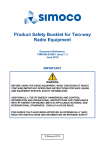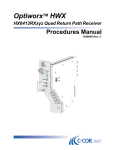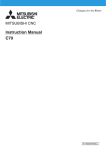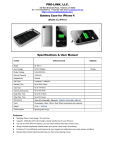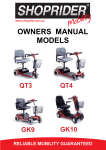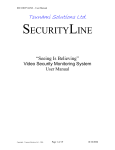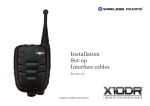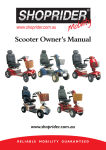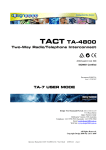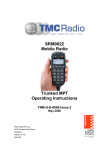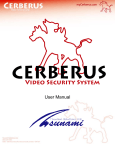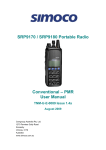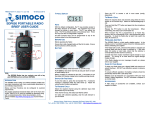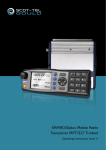Download MWRSM User Manual
Transcript
MWRSM User Manual This product is designed to radiate low levels of radio energy in accordance with global government approved regulatory standards. It features Adaptive Power Output. APO automatically adjusts the RF power output in accordance with signal required. This features limits and reduces extraneous radiated radio energy. This also helps minimize battery consumption and extends battery shift life. Do not touch the antenna when operational. Keep Mobile Microphone antenna 25mm (1”) or more away from your face and body to ensure exposure levels remain at or below the maximum levels. Keep your body at least 20cm/8” from external antennas connected to the Mobile cradle charger unit. Ne touchez pas l’antenne lorsque opérationnel. Gardez sécurisé antenne de microphone 25mm (1“) ou plus loin de votre visage et le corps pour assurer des niveaux d’exposition restent égales ou inférieures aux teneurs maximales. Gardez votre corps au moins 20cm/8 “des antennes externes connectés à l’unité de chargeur mobile charger cradle. IMPORTANT ALWAYS ATTACH THE ANTENNA TO THE MOBILE CRADLE BEFORE THEN CONNECTING THE INTERFACE CABLE. If you would like to review or print out a larger version of this user manual on-line, then go to: www.simocogroup.com 2 Table of Contents Parts & Functions������������������������������������������������������������4 Wearing the MWRSM Mobile RSM���������������������������������5 Operational Description�������������������������������������������������6 Basic Operation���������������������������������������������������������������8 •• •• •• •• •• •• •• •• •• •• •• •• •• •• •• •• •• •• •• Power On & Off, Volume Control����������������������������������8 Transmitting/Receiving, Emergency���������������������������8 Talk permit tone, charging confirmation�������������������9 Earpiece, Out of Range, Stealth�����������������������������������9 Multiple unit operation����������������������������������������������� 10 Motorcycle operation�������������������������������������������������� 11 Headset, covert operation������������������������������������������ 11 Technical notes������������������������������������������������������������� 12 Battery charging����������������������������������������������������������� 12 Replacing the battery pack���������������������������������������� 13 Re-pairing���������������������������������������������������������������������� 14 Audio adjustment��������������������������������������������������������� 14 Antennas������������������������������������������������������������������������ 15 Typical wiring diagram ����������������������������������������������� 16 Installation & connections����������������������������������������� 17 Approvals, ��������������������������������������������������������������������� 19 Warranty ����������������������������������������������������������������������� 20 Important safety and handling��������������������������������� 20 Specifications���������������������������������������������������������������� 26 3 Nomenclature SM = Mobile Microphone MD = Mobile cradle charger X10DRSM_ _-X_1 Model Name Parts and functions Mobile Wireless Microphone U = Standard Model X = Advanced 128 Bit Model Antenna Mobile Charger Volume up Volume down Charging contacts Status light Microphone PTT: Press-To-Talk Status light Loudspeaker Emergency Antenna Manual Connector Off/On Off/On DC charging Headset connector Earpiece jack (Optional) Volume up: adjusts speaker audio louder. Volume down: adjusts speaker audio softer - minimum setting. Microphone: talk in a normal strength voice about 3cm from mic. PTT: press to talk - 3 quick beeps when pressed*. - When out of range the unit will sound a slow beeping tone alert. Emergency: A quick beep sounds when pressed* and then triggers host radio’s emergency function. Hold down button as per mobile radio’s emergency button operating instructions or as advised by your supplier - When out of range the unit will sound a slow beeping tone alert when the button is pressed. Off/On: hold for about 5 seconds to turn on or off. The Mobile mic will sound escalating or de-escalating tones to advise status. 4 DC charging: place into charger to automatically re-charge. A confirmation tone will sound Headset port: use with associated** headsets/accessories. Earpiece jack: allows private listening via 3.5mm earpieces.** Inserting the 3.5mm plug mutes the loudspeaker. Loudspeaker: Delivers loudspeaker audio - Automatically mutes when inserted into Mobile cradle charger. Status light: glows blue* when connected and operational. Flashes when “out of range” or when one unit is off. Antenna Connector: Allows connection of long range external antenna or replacement of short range internal type. **Buy separately as needed. Wearing the MWRSM Mobile Rem Spk Mic NB: Your MWRSM will perform best when worn such that the antenna protrudes above your shoulder. Different types of carry clips are available including: Standard clip This is the traditional type allows the MWRSM Mic to be clipped to work vests, clothing, epaulettes, etc. Rare earth magnets Mobile the microphone in the charger cradle charging cradle. Velcro® mount clip The Velcro mount type features a large Velcro “hook” disc on the back of the microphone. A matching supplied Velcro “loop” patch should be ideally sewn or pinned to the users work attire/vest in the shoulder area to allow the antenna to protrude above you body to ensure maximum range. Rare earth magnets secure the microphone in the charging cradle. Note: Neodium, rare earth magnets, are fragile and can easily break if hit or heavily dropped and will then need to be replaced. (Not covered by warranty) Take extra care when handling them. Keep away from credit cards or like items, that can be damaged by strong magnetic fields. 5 Operational Description Congratulations on choosing the revolutionary MWRSM Mobile wireless remote speaker microphone. This lightweight personal accessory extends the power of the mobile radio to the palm of your hand, whether in and out of the vehicle. MWRSM re-defines mobile network design by increasing user functionality and mobility whilst dramatically improving the effectiveness of your infrastructure investment. This visionary solution provides users out of vehicle communications with the power and performance of their mobile radio. MWRSM for the first time puts the microphone and radio system access into the palm of the users hand when away from the vehicle, delivering true mobility without system compromise. Users can feel totally confident their private communications are kept Mobile due to the smart 64 bit/128 bit encryption (model dependent) functionality. MWRSM uniquely incorporates HLC™ “Hard Line Coding” connection protocol that virtually eliminates any possibility of outside intrusion between the MWRSM and your vehicle’s mobile. When the mission is critical, MWRSM delivers. MWRSM unleashes the power of your mobile radioallowing wireless communication with a fixed located or vehicle radio: up to 300 meters or more. Enhanced audio ensures users can communicate cleary, with the full power and range of their mobile radio, whilst not being tied to the vehicle, allowing the user to be truly mobile in every operational environment. Finally, if you go out of range, the blue LED will flash and the unit will sound a warning tone if you press the PTT or Emergency button so you know to move back into your communication zone or to be simply aware. This ability to now communicate whilst outside your vehicle significantly enhances a safer and more mobile work environment for everyone who carries a MWRSM Mobile wireless remote speaker microphone. 6 How it works ....up to 300 Meters. Mobile WIRELESS COMMUNICATION via your vehicle’s mobile radio 7 Basic Operation Power On & Off Usually the unit will be installed such that it powers off & on with the host mobile radio or by a manual switch fitted by your installation mechanic. You can manually turn off the Mobile cradle charger by pressing the front grey button for 3 seconds and the blue LED will extinguish. You can do the same on the Mobile wireless remote speaker microphone by pressing the grey button. The Mobile mic will sound a de-escalating tone. To power On, do the same, releasing the button once the LED lights. The Mobile mic will sound an escalating tone. The blue LED on both units will flash momentarily and then go solid once they’re connected. Volume Control When you first activate the unit you should first ensure your mobile radio’s volume is set to a comfortable listening level. You may then adjust the Mobile wireless remote speaker microphone volume by pressing the right top button to increase or the left to decrease. There are 5 listening levels. The minimum level is not zero but is designed so you can still quietly hear radio traffic and not inadvertently turn off the audio. Transmitting/Receiving Use like any two way radio speaker microphone i.e. press the large PTT button to talk and release to listen. A short talk permit tone sequence will sound when activated. Speak with a normal strong clear voice about 3-5cm (2”) from the microphone port. Do not yell as this causes loss of clarity. Out of Range Indication MWRSM provides the user with audible feedback should the user move out of range from their vehicle. Note: if you walk out of range the blue status LED will flash. If you then push the PTT an alert tone will sound to let you know your call is not getting though. Pressing the Emergency button when Out of Range will provide a similar indication. Depending on your location, you may find you need to walk back about 10 meters (yards) closer to your vehicle to re-connect - Blue status light will then glow solid. 8 Talk Permit tone MWRSM provides talk permit tones so users know when to start speaking so that words are not lost at the start of a transmission. If, the channel is busy, no channel grant or you are out of range, the user will hear the MWRSM talk permit tones followed by the radio BUSY or Out of Range tone. (can be enabled/disabled by field programmer) Charging Confirmation Tone MWRSM provides the user with a discrete tone whenever the MWRSM Mobile Mic is returned to the charging cradle. This discrete chirp ensures the user has a positive indication that the MWRSM Mobile Mic is charging and seated correctly in the cradle. Earpiece Operation MWRSM provides the user with a weather protected 3.5mm earpiece jack to allow use of industry standard earpieces thereby providing additional privacy of communications. A range of earpiece styles are available to suit individual user preferences. Plugging in an earpiece disables the internal loudspeaker. Emergency The emergency button can be used to trigger and reset the emergency function in your suitably equipped mobile radio. The time you hold the button is the time your mobile radio registers the emergency command. So if your radio requires you to hold the front panel emergency button for 2 secs, then you should hold the Wireless Microphone emergency button for 2 seconds. When you press the emergency (orange) button a short beep will sound. (Can be disabled by use of MWRSM Field programmer). Stealth Mode For special applications the Mobile Mic’s Blue LED on the front of the Mobile Mic can be temporarily disabled. This is achieved by holding down the VOLUME UP/DOWN (both) while powering up the unit. To turn the LED back on, simply power down and power back up. The feature may be of particular use to“Law Enforcement Users” who may prefer in some situations to not be walking around at night with a blue light glowing on their shoulder. 9 Multiple Unit Operation Multiple MWRSM Mobile wireless remote speaker microphones may be connected to one radio device by use of the optional XIB-TA Interface box accessory. Operation is identical to single user operation with the added benefit that, each party also hears each other talk when they transmit. This functionality is ideal for police: where two officers are assigned to a patrol van, or ambulance: where 3 paramedics can communicate at a scene as well as with their control room. It is also ideal for office use allowing a number of personnel to access a local base or control station or remote control console while moving around a building, shop or warehouse. Note: communication between MWRSM users is always routed back through their respective mobile cradle chargers and not direct between units. Ask your dealer for more information on this unique and highly regarded operational capability. INSTALLERS NOTE: Use of the XBDA “booster” accessory is NOT compatible with multiple unit installations. Multiple unit operation requires that antennas are located ideally >50cm (20”) apart to minimise the opportunity for cross unit interference. Attention needs to be made when locating antennas so that each MWRSM provide similar coverage patterns to ensure balanced unit to unit communications. Motorcycle Operation The MWRSM Mobile wireless remote speaker microphone is especially suitable for motorcycle use. Models fitted with a 6 pin Hirose industrial connector allow easy connection to a helmet microphone and dual earpiece fit out. Making use of the handlebar PTT input, a bike can be configured so that, when the rider is on the bike and presses the handle bar PTT, their headset microphone audio is sent out over the radio. Off the bike but still wearing the helmet, the user can press the Mobile wireless remote speaker microphone PTT to talk,. Finally, if the user removes their helmet, they can unplug from the Hirose connector on the base of the unit and just use the Mobile wireless remote speaker microphone like standard. 10 Headset Operation The optional 6 pin Hirose industrial connector also allows use of a variety of heavy duty and lightweight headsets and application specific audio accessories to enhance you communications capability. Use either the headset/accessory’s integral PTT or use the speaker mic PTT to transmit. The internal speaker is immediately disabled when a headset is plugged in. Accessory Mic Boost Users can increase an audio accessory’s microphone gain on MWRSM models fitted with the Hirose accessory port to cater for sensitivity requirements or variations in headset manufacturer’s specifications. To activate the higher sensitivity, the MWRSM’s blue VOLUME UP button should be held down while powering up. The user will thereafter hear 2 short confirmation beeps at the end of each start up tone sequence. To revert to standard operation, the unit should be powered up with the VOLUME DOWN blue button held down. NOTE: this does NOT effect the sensitivity of the MWRSM’s normal internal front cover microphone. N.B. See page 25 for safety warning regarding use of headsets. Covert Operation The small size of the MWRSM unit may allow for its selective use in covert applications. The remote monitor PTT function means someone else can enable “listening” without the covert operative having to touch anything. As audio is duplex (bidirectional) you can also talk to them at the same time allowing vital messages to be passed on even when an operative is transmitting. The advanced model : MWRSM2 unit provides 128 bit encryption version to ensure high levels of voice security, while the standard MWRSM versions provide 64 bit encryption. Both encryption types are based on the well recognized highly Mobile ‘SAFER” format. 11 Technical Notes Battery - Charging The MWRSM Mobile wireless remote speaker microphone should be charged overnight before initial use. Thereafter it may be left in the charger unit between calls, or may be worn all day and placed back at the end of the work day. The unit is designed to provide about 15-24 hours operation between charges even on the busiest radio channels. On quiet channels it can last up to 3-4 days. When the battery does start to go flat, a short beep will sound once every 2 minutes. It will then automatically power down after 30 minutes, so you should plan to re-charge the unit as soon as is practical once the chirps are heard. A fully discharged battery will typically recharge in less than 3-4 hours, or less if only partially discharged. The battery will recharge even if the mobile charger unit has been turned off. The microphone’s blue status light will indicate charging mode. Simply place into pocket. The MWRSM will beep to show correct placement. NB: do not allow debris to fill the pocket as it may prevent the microphone from making contact with the charging pins Keep all liquids well away from the charging cradle at all times. 12 Li-POL Please recycle thoughtfully Replacing the battery pack When you notice the MWRSM sounding a small chirp every couple of minutes, it indicates the battery is nearly flat and should be re-charged. The unit will self power down after about 30 minutes when voltage drops to the minimum level. When you notice this occurring far more often than usual, it may mean it is time for the battery to be replaced. Like all re-chargeable products, periodic replacement of the internal battery is required. The Mobile wireless remote speaker microphone features a high capacity Lithium Ion battery. To maximize the life of a Lithium battery its is better to keep it topped up by returning it to the charger often rather than waiting for it to first go flat - which was the opposite case with older nickel based batteries. Typically you can expect to get about 500 re-charge cycles before the battery will require replacement. The process is simple and should only take your radio service supplier about 5 minutes to replace and test. Replacement of the battery should be ONLY undertaken by a qualified service technician so as to ensure no damage occurs to internal circuitry and to ensure the housing’s weatherproof integrity is not compromised. After replacement, the Mobile wireless remote speaker microphone must be first placed back into the mobile charger and will initially should be charged for 4-6 hours prior to commencement of use. 13 Re-pairing Each MWRSM Mobile wireless remote speaker microphone is uniquely connected to a specific Mobile cradle charger in the factory. This ensures that all communications between the two units are Mobile and cannot be compromised or interfered with by a third party. In the event of a Mobile wireless remote speaker microphone being lost, it can be permanently disconnected from the Mobile cradle charger by connecting with a new replacement unit. How to re-pair: hold the speaker mic while pressing both the blue volume controls un- Press blue buttons til the blue LED flashes and the speaker mic together until LED flashes and unit beeps.(after 8 secs.) Now place the speaker mic beeps back into the mobile charger. After a few seconds the speaker mic will sound a confirmation two tone and the blue LED on both units will glow solid to indicate connection is complete. IMPORTANT - READ THIS Audio adjustments Qualified service personnel only! When installing the MWRSM system you should first carefully adjust the transmit and receive audio levels via the trimpots on the bottom of the Charger cradle device. TRANSMIT: while listening on another radio, talk VR1into the Mobile Mic and adjust VR1 so it sounds Tx VR2 - Rx the same volume and clarity as the host mobiles wired microphone. RECEIVE: Using another radio, talk into its microphone and adjust VR2 so that the audio received through the MWRSM speaker is loud and clear with the MWRSM Volume turned up near maximum. 14 Antennas As compared to the basic internal 1/4 wave stub antenna, the optional magnetic mount antenna provides enhanced coverage when placed on an unobstructed area of a vehicle’s roof and should be connected via its low loss coax cable to the RP-SMA-F output on the mobile charger. MAKE SURE YOU FULLY TIGHTEN! The optional multi-polarity antenna provides even greater coverage in multipath - non line of sight - situations. It should be mounted onto an unobstructed area on or above the vehicle’s roof line and should always be connected via the supplied low loss coax cable to the MWRSM cradle connector. MAKE SURE YOU FULLY TIGHTEN! Alternatively, where approved, the XBDA bidirectional amplifier may also be installed to further enhance in-building coverage from your vehicle. The XBDA is installed in series between the antenna and the mobile charger using a 20cm (8”) length of RG174 coax cable and a 5.2M (17’) length of LMR200 type coax to ensure a maximum of 1W output to the antenna. Only qualified radio service personnel should install a XBDA so as to ensure the effective radiation level remain in full compliance with regulatory requirements in your country of operation. XBDA is not approved for CE countries and some other markets. Keep your body at least 20cm (8”) away from vehicle mounted external antenna. See page 21 for other important details. Warning: In the event of a damaged or lost antenna, only original replacements should be used so as to not compromise the units type approval certification or performance. The speaker microphone uses a unity gain ground independent antenna for maximum multi-directional range. The mobile charger output has a reverse polarity SMA female antenna connector, as does the XBDA. 15 DB15 F PUR RED GRN ORG YEL BLK ORG RED BRN BLK 13 1 2 3 4 5 6 7 8 9 PUR ORG PURPLE - Handle bar PTT RED 24AWG ignition In ORANGE- Emerg Output 1 2 "YELLOW"CRIMP JOINERS FITTED BLACK BLUE RED BLACK connector is used for ignition sense input, but some SRM9000 models may be internally modified/jumpered to make this an emergency input. In such cases, join that thin red wire to Orange emeregency out wire. 4,5,11,12 14 1,2,9,10 13 4,5,11,12 7 3 8 1,2,9,10 6 13 BLU BLK (Spk socket) 24SAWG 22# BLK 22# RED RED EMERGENCY: normally the thin 24AWG Red wire on Pin 3 of the radio Remote/ footswitch/Handle bar PTT Drain connects to shell Switched B+ from radio Audio out to radio Ext Mic Hi Mic Lo to radio Received audio from radio Power nominal +12VDC Ext PTT to radio Emergency out to radio COR/ Audio unmute from radio DC/ Digital Ground (adds X10DR Interface cable to an existing SRM power cable) 9A0D1000ZXL Interface cable for SRM9000 series: 16 Installation & Connections 1. Switched B+: Used to automatically turn on/off Mobile wireless rem. spk. mic. if connected to host radio switched B+ output, if not, the user should supply manual on/off switch. Note: internal speaker microphone battery will still charge when the unit is turned off. 2. External Mic Audio: Audio from the Wireless Microphone that is to be transmitted over the host mobile radios transmitter. Adjust VR1 so MWRSM audio matches the level from mobile mic. 3. Radio Mic Lo: This is microphone audio ground. 4. Receive Audio: Receive audio from the host mobile radio that you wish to be sent to the Wireless Microphone. Ideally, it should be sourced pre-volume control but can be post, as long as the host mobile radio’s speaker audio has first been sent for a comfortable listening level in the vehicle. 5. Power: connected via a 1 amp in-line fuse preferably direct to a vehicle’s 12V battery but can be any voltage from about 6-16VDC. Current consumption is typically 60mA/Max current 420mA@6V. (12V = <200mA) 6. Ext. PTT: Switched ground output designed to cause the host mobile radio to transmit. 7. Emergency: Output intended to connect to the host mobile radio’s emergency input. It is normally provides an active switched ground but can be configured to be active open circuit. The time held low (or high) is the exact time that the user presses the Emergency button. This output could be used for other functions such as to trigger the panic function of a car alarm system, providing it is correctly “buffered”. 17 8. COR/squelch/audio unmute: Input designed to monitor the receive status of the host mobile radio. Ideally, it is driven by an “audio unmute” switched ground command in the host mobile. i.e. when the radio’s speaker unmutes to pass audio then the COR input should toggle in sync. Alternatively, it could be driven by the radio’s unsquelch command that factors in reception of required correct CTCSS tones, etc. An internal dip switch caters for active low or high inputs. Where COR is not available the MWRSMs vox capability in most cases alows satisfactory operation. 9. Ground: DC /Digital ground connection. 13. Remote PTT: This provides a remote alternative to transmit Mobile microphone audio via the host mobile radio. You may choose to connect to a motorbike handle bar PTT, a hidden palm or footswitch, a wireless PTT device, or even to an output from the host mobile equipped to provide remote radio monitoring of the Mobile microphones users audio. In such remote monitoring cases, use of the remote PTT input causes the sensitivity of the INTERNAL Mobile microphone to be greatly increased, so a control room operator can more easily monitor the health or safety of the user. There is no increased audio gain when a headset is connected to the audio port at the base of the Mobile microphone. 18 Type Acceptance RADIO AND TELEVISION INTERFERENCE The equipment described in this manual generates, uses, and radiates radio-frequency energy. Ifit is not installed and used correctly—it may cause interference with others. CE DECLARATION This equipment has been tested and found to comply with the following harmonised European Norms: •EN300328 (radio and telecommunications terminal equipment) •EN55024 (electromagnetic immunity) •EN55022 Class B (electromagnetic emissions) •EN 60950 (electrical safety) •EN301489 (electromagnetic compatibility and radio spectrum matters) Based on the results of these tests, Simoco declares that the above mentioned devices conform to Article 10.1 of the European Council Directive 89/336/EEC, and their amendment Directive 93/68/EEC, and to the Directive 1999/5/EC and indicates this conformity by the CE-sign on each device. The device must be installed and operated in strict accordance with the instructions given in this user manual. Any changes or modifications to this product that were not specifically authorised will invalidate this declaration. FCC NOTICE This equipment complies with Part 15 of the FCC Rules. Operation is subject to the following two conditions: (1) this device may not cause harmful interference, and (2) this device must accept any interference received, including interference that may cause undesired operation. This equipment has been tested and found to comply with the limits for a Class B digital device, pursuant to Part 15 of FCC Rules. These limits are designed to provide reasonable protection against harmful interference in a residential installation. This equipment generates, uses and can radiate radio frequency energy and, if not installed and used in accordance with the instructions, may cause harmful interference to radio communications. However, there is no guarantee that interference will not occur in a particular installation. You can determine whether the equipment is causing interference by disconnecting power. If the interference stops, it was probably caused by the equipment. If the equipment does cause interference to radio or television reception, you may be able to correct the interference by using one or more of the following measures: •Rotate the television or radio’s antenna until the interference stops. •Move the Wireless Microphone farther away from the television or radio. If necessary, consult your two way radio dealer or an experienced radio/television technician for help. Changes or modifications to this product not authorized by Simoco Ltd could void the FCC Certification and negate your authority to operate the product. Notice : Changes or modifications not expressly approved by the party for compliance could void the user’s authority to operate the equipment. IMPORTANT NOTE: To comply with the FCC RF exposure compliance requirements, no change to the antenna or the device is permitted. Any change to the antenna or the device could result in the device exceeding the RF exposure requirements and void user’s authority to operate the device. INDUSTRY CANADA: This device complies with Industry Canada licence-exempt RSS standard(s). Operation is subject to the following two conditions: (1) this device may not cause interference, and (2) this device must accept any interference, including interference that may cause undesired operation of the device. Le présent appareil est conforme aux CNR d’Industrie Canada applicables aux appareils radio exempts de licence. L’exploitation est autorisée aux deux conditions suivantes : (1) l’appareil ne doit pas produire de brouillage, et (2) l’utilisateur de l’appareil doit accepter tout brouillage radioélectrique subi, même si le brouillage est susceptible d’en compromettre le fonctionnement. 19 Warranty Simoco warrants each new product sold by Simoco to be free from defects in material and workmanship under normal use and service. The obligation and liability of Simoco under this warranty is limited to the repair or replacement at its factory, at the option of Simoco, of any such product which proves defective within the quoted warranty period, twelve (12) months for Simoco products after delivery, and is found to be defective in material and workmanship by Simoco inspection. Products of warranty consideration shall be returned with all transportation charges prepaid to Simoco or our nominated local service supplier in shipping containers which are adequate to prevent loss or damage in shipment. Simoco will pay the return carriage costs for Simoco products. Products repaired or replaced under this warranty are warranted for the unexpired portion of the original warranty. This warranty is invalid if the factory-applied serial number, date code label, or product label has been altered or removed from this product . Simoco shall not be obligated or liable under the warranty for apparent defects which examination discloses are due to tampering, misuse, neglect, improper storage, acts of nature, physical abuse, normal wear and all cases where the products are disassembled by other than authorised Simoco representatives. In addition, Simoco shall not be obligated or liable under this warranty unless the date of delivery to the first end user shall be within one (1) month from the date of delivery to the original purchaser, if different from the first end user, and further provided that written notice of any defect shall be given to Simoco within thirty (30) days from the date such defect is first discovered. In no event will Simoco accept consequential damages for products supplied and are then found to have become defective. Repairing or Modifying MWRSM: Never attempt to repair or modify MWRSM yourself. MWRSM does not contain any user-serviceable parts, Disassembling an MWRSM, including the removal of external screws and back cover, may cause damage that is not covered under the warranty. If an MWRSM has been submerged in water, punctured, or subjected to a severe fall, do not use it until you take it to an SIM Authorsed Service Provider. Service should only be provided by Simoco or a Simoco Authorised Service Provider. If you have questions or for service information, contact Simoco or a Simoco Authorised Service Provider. 20 Important Safety and Handling Information To avoid injury, read all operating instructions and the following safety information before using MWRSM. For downloadable versions of the latest MWRSM User Guide, visit: www. wirelesscorpltd.com WARNING: Failure to follow these safety instructions could result in fire, electric shock, or other injury or damage to MWRSM or other property. Read all safety instructions for any products and accessories before using with MWRSM. SIM is not responsible for the operation of, or any damage caused by, third-party accessories or their compliance with safety and regulatory standards. Radio Frequency Interference: Radio frequency emissions from electronic equipment can negatively affect the operation of other electronic equipment, causing them to malfunction. Although MWRSM is designed, tested and manufactured to comply with regulations governing radio frequency emission in countries such as the United States, Canada, the European Union, and Japan, the wireless transmitters and electrical circuits in the MWRSM may cause interference in other electronic equipment. Therefore, please take the following precautions: i/Aircraft: Use of MWRSM may be prohibited while travelling in aircraft. ii/Vehicles: radio frequency emissions from MWRSM may affect electronic systems in motor vehicles. Check with the manufacturer or its representative regarding your vehicle. iii/Pacemakers: The Health Industry Manufacturers Association recommends that a minimum separation of 15 cm (6 inches) be maintained between a handheld wireless phone and a pacemaker to avoid potential interference with the pacemaker. Persons with pacemakers: • • • • • Should always keep MWRSM more than 15 cm (6 inches) from the pacemaker when turned on. Should not carry MWRSM in a breast pocket. Should use the ear opposite the pacemaker to minimize the potential for interference If you have any reason to suspect that interference is taking place, turn MWRSM off immediately. MWRSM may interfere with some hearing aids. If you experience interference, consult the hearing aid manufacturer or your physician for alternatives or remedies. v/ Other Medical Devices: If you use any other personal medical device, consult the device manufacturer or your physician to determine if it is adequately shielded from radio frequency emissions from MWRSM. vi/Health Care Facilities: Hospitals and health care facilities may use equipment that is particularly sensitive to external radio frequency emissions. Turn MWRSM off when staff or posted signs instruct you to do so. vii/Blasting Areas and Posted Facilities: To avoid interfering with blasting operations, turn off the MWRSM when in a “blasting area” or in areas posted “Turn off two-way radio.” Obey all signs and instructions. 21 Exposure to Radio Frequency Energy: The unit transmits and receives radio frequency (RF) energy through its antennas. The antennas are located at the top edge of the unit. The Wireless Speaker Microphone is designed and manufactured to comply with the limits for exposure to RF energy set by international regulatory agencies, including the FCC of the United States, IC of Canada, MIC of Japan, and the Counsel of the European Union, among others. The unit has been tested and meets the FCC, IC, and European Union RF exposure guidelines for 802.15 operation. To ensure exposure levels remain at or below the maximum safe levels, when carrying the unit ONLY use the Wireless Speaker Microphone with the manufacturer’s supplied clothing clip or a nonmetallic holder that ensures the antenna remains greater than 25mm (1 inch) from your body at all times. An external antenna is connected to the output connector on the mobile charger or to the output connector on the XBDA bidirectional amplifier. Always keep your body at least 20cm (8”) from the vehicle mounted external antenna. The XBDA is only approved for use with the Charger cradle unit when in accordance with individual country type approval regulations. Potentially Explosive Atmospheres: Turn off MWRSM when in any area with a potentially explosive atmosphere. Do not charge MWRSM, and obey all signs and instructions. Sparks in such areas could cause an explosion or fire, resulting in serious injury or even death. Areas with a potentially explosive atmosphere are often, but not always, marked clearly. Potential areas may include: fuelling areas (such as gas stations); below deck on boats; fuel or chemical transfer or storage facilities; vehicles using liquefied petroleum gas (such as propane or butane); areas where the air contains chemicals or particles (such as grain, dust, or metal powders); and any other area where you would normally be advised to turn off your vehicle engine. Battery Replacement: Do not attempt to replace the rechargeable battery in MWRSM yourself. The battery should be replaced only by SIM or an SIM Authorized Service Provider. The battery should be recycled/disposed of thoughtfully. Antenna Replacement: Only use the antennas supplied. Use of other antenna types will void type approval. This radio transmitter (IC:11443A-X10DRMD) was approved by Industry Canada to operate with the antenna types listed below the maximum permissible gain and required antenna impedance for each antenna type indicated. Types of antennas is not included in this list, having a higher gain than the maximum gain indicated this type are strictly prohibited for use with this device. Cet émetteur radio (identifier le dispositif par numéro de certification ou le numéro de modèle de la catégorie II) a été approuvé par Industrie Canada pour fonctionner avec les types d’antenne énumérés ci-après le gain maximal autorisé et de l’impédance d’antenne requise pour chaque type d’antenne indiqué. Types d’antennes ne sont pas inclus dans cette liste, ayant un gain supérieur au gain maximum indiqué ce type sont strictement interdits pour une utilisation avec cet appareil. 22 Informations importantes de sécurité et de manutention Pour éviter toute blessure, lisez toutes les instructions et les consignes de sécurité suivantes avant d’utiliser MWRSM. Pour les versions téléchargeables de la dernière version du Guide de l’utilisateur de MWRSM, visitez: www.wirelesscorpltd.com AVERTISSEMENT: Le non-respect de ces consignes de sécurité peut provoquer un incendie, de choc électrique ou d’autres blessures ou de dommages à MWRSM ou d’autres biens. Lisez toutes les instructions de sécurité pour tous les produits et accessoires avant d’utiliser avec MWRSM. CMT n’est pas responsable de l’exploitation, ou tout dommage causé par des accessoires tiers ou de leur conformité aux normes de sécurité et réglementaires. Radio Frequency Interference: L’émission de fréquences radio émises par les équipements électroniques peuvent affecter négativement le fonctionnement des autres appareils électroniques, les obligeant à un dysfonctionnement. Bien MWRSM est conçu, testé et fabriqué conformément aux règlements régissant l’émission de radiofréquences dans les pays comme les États-Unis, le Canada, l’Union européenne et le Japon, les émetteurs sans fil et les circuits électriques dans le MWRSM peut provoquer des interférences avec d’autres équipements électroniques. Par conséquent, s’il vous plaît prendre les précautions suivantes: i / Avion: L’utilisation de MWRSM peut être interdite dans les avions. ii / Véhicules: les émissions de radiofréquences par des MWRSM peuvent affecter les systèmes électroniques des véhicules à moteur. Vérifiez auprès du fabricant ou de son représentant votre véhicule. L’exposition à l’énergie radioélectrique : L’unité émet et reçoit des fréquences radio (RF) par l’intermédiaire de ses antennes. Les antennes sont situés au niveau du bord supérieur de l’unité . Le Président de microphone sans fil est conçu et fabriqué pour respecter les limites d’exposition à l’énergie RF fixées par les organismes de réglementation internationaux, y compris la FCC des États-Unis , du Canada IC , MIC du Japon , et l’avocat de l’Union européenne , entre autres . L’appareil a été testé et répond aux FCC , IC , et l’Union européenne RF normes d’exposition applicables 802.15 opération. Pour assurer des niveaux d’exposition restent égales ou inférieures aux limites maximales de sécurité , pour transporter l’appareil , utilisez uniquement le Président de microphone sans fil avec fourni des vêtements clip de fabricant ou un support non métallique qui assure l’antenne reste supérieure à 25 mm (1 po) du votre corps à tout moment. Une antenne externe est connectée au connecteur de sortie du chargeur mobile ou au connecteur de sortie de l’amplificateur bidirectionnel XBDA . Toujours garder votre corps au moins 20 cm ( 8 “ ) de thevehicle antenne externe installée . Le XBDA n’est approuvé pour une utilisation avec l’unité X - Ponder lorsque conformément à la réglementation en matière d’homologation de chaque pays . Atmosphères explosibles: Désactiver MWRSM dans des zones avec une atmosphère potentiellement explosive. Ne chargez pas MWRSM, et respectez tous les panneaux et instructions. Des étincelles dans de telles zones pourraient causer une explosion ou un incendie, causant des blessures graves ou même la mort. Les zones à atmosphère potentiellement explosive sont souvent, mais pas toujours, clairement indiquées. Les zones potentielles comprennent: les zones de carburant (comme les stations d’essence), au-dessous du pont des bateaux, de carburant ou de transfert ou au stockage de produits chimiques, les véhicules utilisant du gaz de pétrole liquéfié (comme le propane ou le butane), des zones où l’air contient des produits chimiques ou des particules (le grain, la poussière ou les poudres métalliques) et tout autre endroit où il vous serait normalement recommandé d’arrêter le moteur de votre véhicule. 23 XBDA Use Under Industry Canada regulations, this radio frequency power amplifier may only be used with the transmitter with which the amplifier has been certified by Industry Canada. The certification number for the transmitter with which this amplifier is permitted to operate is IC:11443A-X10DRMD. En vertu des règlements d’Industrie Canada, cet amplificateur de fréquence radio de faible puissance ne peut être utilisé avec l’émetteur avec lequel l’amplificateur a été certifié par Industrie Canada. Le numéro de certification pour l’émetteur avec lequel cet amplificateur est autorisée à opérer est IC: 11443A-MWRSMMD. Charging your MWRSM: To charge MWRSM, use only the Simoco mobile or desktop charger. When you use the Simoco desktop charger to charge MWRSM, make sure that the power adapter is fully assembled before you plug it into a power outlet. Then insert the SIM AC/ DC plug pack firmly into the power outlet. Do not connect or disconnect the SIM AC/DC plug pack with wet hands. The Simoco AC/DC plug pack may become warm during normal use. Always allow adequate ventilation around the SIM AC/DC plug pack and use care when handling. Unplug the SIM AC/DC plug pack if any of the following conditions exist: 1/ The power cord or plug has become frayed or damaged. 2/ The adapter is exposed to rain, liquid, or excessive moisture. 3/ The adapter case has become damaged. 4/ You suspect the adapter needs service or repair. 5/ You want to clean the adapter. Cleaning your MWRSM: Clean MWRSM immediately if it comes into contact with any contaminants that may cause possible malfunctions—for example, ink, dyes, makeup, dirt, food, oils, and lotions. To clean MWRSM, unplug all cables and turn off MWRSM (press and hold the manual On/Off button). Then use a soft, slightly damp cloth. Don’t use abrasive household or industrial cleaners, aerosol sprays, solvents, alcohol, ammonia to clean MWRSM. Connectors and Press Buttons: Never force a connector into a port or apply excessive pressure to a button, because this may cause damage that is not covered under the warranty. If the connector and port don’t join with reasonable ease, they probably don’t match. Check for obstructions and make sure that the connector matches the port and that you have positioned the connector correctly in relation to the port. Not all Hirose 6 pin accessories are fully compatible with MWRSM. Under some conditions, certain accessories may affect MWRSM wireless performance. Reorienting or relocating MWRSM and the connected accessory may improve wireless performance. Acceptable Temperature Extremes: MWRSM is designed to be normally operated and stored in temperatures between -20º and 55ºC (-4º to 122ºF). Lower or higher temperature conditions might shorten battery life or cause MWRSM to temporarily stop working correctly. Leaving MWRSM in a parked vehicle or in direct sunlight can cause MWRSM to exceed these storage or operating temperature ranges. Avoid dramatic changes in temperature or humidity when using MWRSM, as condensation may form within the unit. When you’re using MWRSM or charging the battery, it is normal for MWRSM to get warm. Battery will only charge when its ambient temperature is within safe limits. 24 Driving Safely: Use of MWRSM while driving a vehicle or riding a motorbike may be distracting. If you find using MWRSM disruptive or distracting while driving or riding, pull off the road and park before making or answering a call. Use of MWRSM alone or with headphones (even if used only in one ear) while driving or riding is not recommended and is illegal in some countries. Check and obey the laws and regulations regarding the use of mobile devices like MWRSM in the areas where you drive or ride. Air Bag Equipped Vehicles: An air bag inflates with great force. Do not store MWRSM or any of its accessories in the area over the air bag or in the air bag deployment area. Carrying and handling MWRSM: MWRSM contains sensitive components. Do not drop, disassemble, microwave, burn, paint, or insert foreign objects into MWRSM. Do not use MWRSM if it has been damaged—for example, if MWRSM is cracked, punctured, or damaged by water. Headset use warning Headsets and earpieces used with this product are capable of delivering sounds at loud volumes. Exposure to such sounds can result in permanent hearing loss damage. The volume level may vary based on conditions such as host radios volume settings and the environment. Please read the following safety guidelines below prior to using a headset or earpiece: 1. Prior to using this product follow these steps: •Before putting on the headset, turn the volume control to its lowest level, •Put the headset on, and then slowly adjust the volume control to a comfortable level. 2. During the use of this product: •Keep the volume at the lowest level possible and avoid using the headset in noisy environments where you may be inclined to turn up the volume; •If increased volume is necessary, adjust the volume control slowly. •If you experience discomfort or ringing in your ears, immediately discontinue using the headset and consult a physician. With continued use at high volume, your ears may become accustomed to the sound level, which may result in permanent damage to your hearing without any noticeable discomfort. Using a headset while operating a motor vehicle, motorcycle, watercraft may be dangerous, and is illegal in some jurisdictions. Check your local regulations and laws. 25 Specifications Subject to change or improvement without notice MWRSM has been designed to meet the following global specifications: Models: MWRSM Standard/ MWRSM2Advanced Dimensions: 88 x 28 x 63mm (spk mic) 80 x 80 x 60 (chgr) 3.46 x 1.1 x 2.48” (spk mic) 3.15 x 3.15 x 2.36” (chgr) Weight: 149 grams (spk mic) 125 grams (chgr) 5.25 oz (spk mic) 4.4oz (chgr) Frequency: 2.40-2.48GHz FH Spread Spectrum Protocol: 802.15.4 based derivative RF Power: <100mW / Charger cradle <1W with XBDA Battery Type: 3.7V @1450mA Lithium Polymer Battery Life: >15 Hours @ 30% receive time Encryption: SAFER+ 64Bit std/ 128Bit Advanced model RF Connectors: RP SMA Female Rated Audio/Distortion: >250mW @5% THD Hirose Audio port: Standard on MWRSM2/option on MWRSM 3.5mm Audio port: Standard Operating Voltage: 6-16VDC Operating Temperature: -20ºC to +55ºC /-4ºF to +122ºF Shock & Vibration: Mil Std 810 C/D/E/F Humidity/Rain/Dust: IEC529, IP55 (spk mic only) Type Acceptance: CE, FCC, IC, Aust/NZ, SIN, Qatar, Brazil, Type Acceptance FCC ID: I7OBT-24H / I7OBT-24D IC:11443A-X10DRSM IC:11443A-X10DRMD Location of labelling C C Simoco X10DRSM-XU1 FCC IC Label.pdf M M 0681 Y Y CM CM X10DRSM-XU1 Wireless Spk Mic N13187 MY Li-Ion 26 3.7V@1200mA Made in Taiwan N13187 10/17/14 4:09:49X10DRMD-XU1 PM Simoco FCC-IC Label.pdf X10DRMD-XU1 X-ponder charger FCC ID: I7OBT-24H IC:11443A-X10DRSM MY 2.4GHz CY CY CMY CMY K K FCC ID: I7OBT-24D IC:11443A-X10DRMD 12V@120mA (max) Made in Taiwan N13187 2.4GHz 10/17/14 4 *IMPORTANT: MWRSM performs best when worn with the antenna protruding up above your shoulder. This helps reduce the effects of body shielding and enhances overall coverage. Coverage is always dependent on the local terrain, obstacles and the overall communications environment. For longer distances, an external antenna should always be fitted to the vehicle. For best performance we recommend you use our multi-polarity antennas. A variety of specialist vehicle antenna configurations are available to enhance into-building penetration or, to simply extend the overall communication zone around your vehicle. Ask your dealer which antenna configuration best suits your specific application. Units operate in the 2.4GHz unlicensed band and may be subject to external interferences from others at times. 27 All rights reserved ©2015 All trademarks or registered trademarks are the property of their respective owners: Manual revision O




























